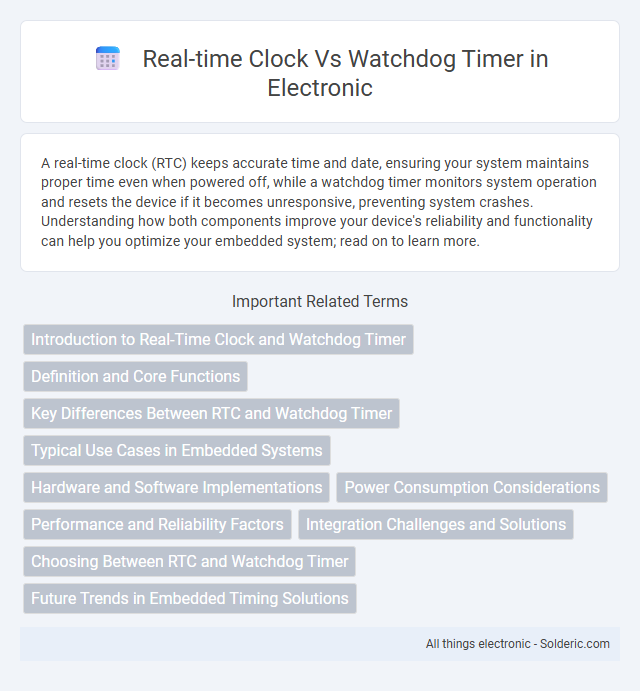A real-time clock (RTC) keeps accurate time and date, ensuring your system maintains proper time even when powered off, while a watchdog timer monitors system operation and resets the device if it becomes unresponsive, preventing system crashes. Understanding how both components improve your device's reliability and functionality can help you optimize your embedded system; read on to learn more.
Comparison Table
| Feature | Real-time Clock (RTC) | Watchdog Timer (WDT) |
|---|---|---|
| Purpose | Keeps accurate time and date | Monitors system operation and triggers reset on failure |
| Function | Maintains time counters continuously | Counts down to reset system if software hangs |
| Usage | Time-stamping, alarms, scheduling tasks | System reliability and fault recovery |
| Operation Mode | Runs independently, even during power-off (with backup battery) | Requires periodic reset signals from system to prevent reset |
| Power Source | Backup battery or main power | Powered by main system |
| Output | Time and date data, interrupts/alarms | System reset or interrupt |
| Typical Application | Embedded systems, clocks, data loggers | Microcontrollers, embedded systems for fault detection |
Introduction to Real-Time Clock and Watchdog Timer
Real-time clocks (RTCs) maintain accurate timekeeping by continuously tracking the current time and date, powered by a dedicated crystal oscillator and backup battery to ensure precision during power outages. Watchdog timers (WDTs) serve as hardware timers designed to reset microcontrollers or systems automatically if the software becomes unresponsive, enhancing system reliability and fault recovery. Both RTCs and WDTs play critical roles in embedded systems by managing time-sensitive functions and maintaining operational stability.
Definition and Core Functions
A real-time clock (RTC) is a hardware device designed to keep track of the current time and date continuously, even when the main system is powered off, ensuring accurate timekeeping for your applications. A watchdog timer (WDT) is a supervisory timer that resets the system if the software becomes unresponsive, protecting your device from crashes or malfunctions. Both components serve distinct purposes: the RTC maintains consistent real-time information, while the watchdog timer ensures system reliability and stability.
Key Differences Between RTC and Watchdog Timer
Real-time clocks (RTC) provide accurate timekeeping by maintaining the current time and date, essential for timestamping events and scheduling tasks in embedded systems. Watchdog timers (WDT) serve as fail-safe mechanisms that reset the system if software malfunctions or becomes unresponsive, ensuring system reliability and stability. Unlike RTCs that track elapsed time continuously, watchdog timers monitor system activity and trigger corrective actions to prevent system hangs or crashes.
Typical Use Cases in Embedded Systems
Real-time clocks (RTCs) are crucial in embedded systems for maintaining accurate timekeeping during power cycles, enabling applications such as data logging, scheduling, and timestamping. Watchdog timers serve as a fail-safe mechanism to automatically reset the system if the software becomes unresponsive, ensuring reliability in safety-critical environments like automotive control units and industrial automation. Your choice between an RTC and a watchdog timer depends on whether time precision or system stability is the priority in your embedded application.
Hardware and Software Implementations
Real-time clocks (RTCs) and watchdog timers serve distinct functions in embedded systems, with RTCs primarily providing accurate timekeeping through dedicated hardware modules powered by a crystal oscillator or battery source. Watchdog timers, implemented via hardware counters or software routines, monitor system operation and initiate a reset if the system becomes unresponsive, ensuring reliability and fault recovery. Software implementations of RTCs often involve synchronization with network time protocols, while watchdog timers rely on periodic software "kicks" or resets to prevent unintended system halts.
Power Consumption Considerations
Real-time clocks (RTCs) are designed to operate with minimal power consumption, often using a dedicated low-frequency oscillator and running on small batteries or capacitors, making them ideal for maintaining accurate time even during power outages. Watchdog timers typically consume slightly more power as they continuously monitor system activity to reset the device during faults, which can impact battery life in low-power applications. Choosing between RTCs and watchdog timers for power-sensitive designs requires balancing their essential functions against the overall system energy budget.
Performance and Reliability Factors
Real-time clocks (RTCs) offer precise timekeeping essential for timestamping and scheduling tasks with high accuracy, enhancing system reliability by maintaining consistent time data even during power cycles. Watchdog timers improve performance by automatically resetting the system during software malfunctions or hangs, preventing prolonged downtimes and ensuring continuous operation. Your system's reliability and performance significantly benefit from integrating RTCs for accurate timing and watchdog timers for fault recovery, creating a robust and resilient embedded environment.
Integration Challenges and Solutions
Real-time clocks (RTCs) and watchdog timers (WDTs) often face integration challenges due to differing clock sources, power requirements, and interrupt signaling methods. Solutions include using low-power embedded RTC modules with synchronized crystal oscillators and integrating WDTs with configurable timeout intervals and reset logic compatible with system firmware. Combining RTCs with WDTs on a single chip or MCU simplifies design while ensuring precise timekeeping and reliable system recovery.
Choosing Between RTC and Watchdog Timer
Choosing between a real-time clock (RTC) and a watchdog timer depends on the system requirements, where RTCs provide precise timekeeping for timestamping and scheduling tasks, while watchdog timers ensure system reliability by resetting the device during software malfunctions. RTCs are essential in applications needing accurate time tracking, such as data logging and alarm systems, whereas watchdog timers are critical in safety-critical systems to prevent system lockups. Evaluating power consumption, accuracy needs, and fault tolerance helps determine the optimal choice for embedded system design.
Future Trends in Embedded Timing Solutions
Future trends in embedded timing solutions emphasize integration of real-time clocks (RTCs) and watchdog timers (WDTs) with enhanced power efficiency and adaptive accuracy for IoT and wearable devices. Advances in low-power semiconductor technology and AI-driven predictive algorithms improve RTC synchronization and WDT fault detection, enabling smarter system reliability. Emerging solutions prioritize miniaturization and customizable timing intervals, supporting increasingly complex, real-time embedded applications across automotive, industrial, and consumer electronics sectors.
Real-time clock vs Watchdog timer Infographic

 solderic.com
solderic.com